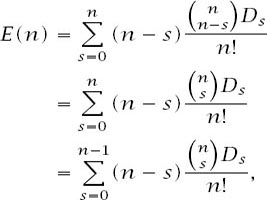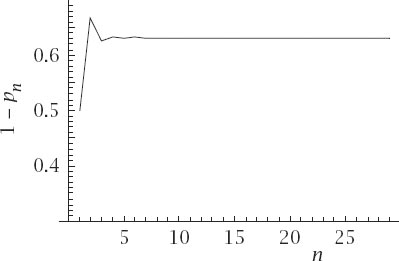Nonplussed! (13 page)
Authors: Julian Havil


where
q
r
is the probability of there being precisely
r
fixed values, which in our case is given by

The argument is that of the previous section, with the
r
fixed values chosen in any of ways, leaving the remaining
ways, leaving the remaining
(n -r)
numbers to be deranged. Our average value is, then,

To evaluate the expression, we will change variable by writing
s = n - r
to get

where the middle equality uses the symmetry of the binomial coefficients

This means that

Multiplying both sides by
(n -
1
)
! results in

and this expression is just equation (1) on page 53 with
n
replaced by
n -
1. This means that
(n -
1
)
!
E(n) = (n -
1
)
! and so
E(n) =
1, independent of
n
.
Asymptotic Behaviour
We have, then, an attribute,
E(n)
, which is independent of the number of objects
n
and, if we look a little more closely at our earlier calculations, we can readily see that

is also practically independent of
n
.
Put more positively, 1
- p
n
is the probability of at least one match with
n
objects and simple computer calculations show that

the two match to six decimal places, so it doesn’t really matter whether we play the original Montmort version of the game or the version considered by Euler.
Figure 5.1 shows the plot of 1
- p
n
against
n
as a continuous function of
n
with that rapid convergence very evident. Put succinctly, there is about a 63% chance of at least one match, virtually independent of
n
, which is perhaps higher than one might imagine.
Finally, we will look a little more closely at the series which gives
p
n
.

Figure 5.1.
Asymptotic behaviour
An Appearance of e
That expression

has a familiar look to it and if we examine the first
n
terms of the Taylor expansion of

